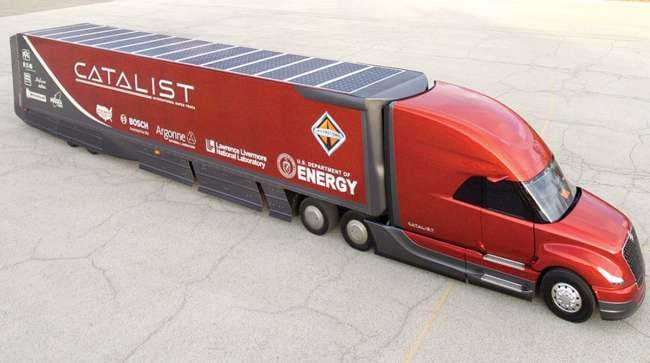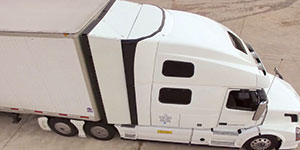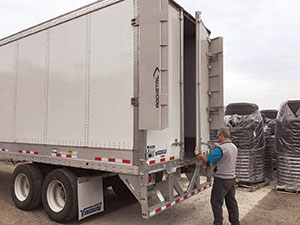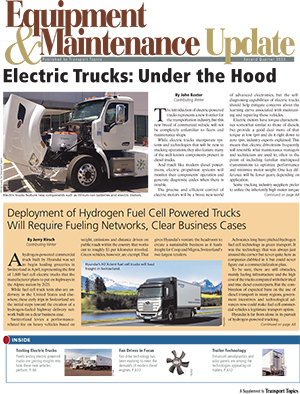New Technologies Target Trailer Efficiency

[Stay on top of transportation news: Get TTNews in your inbox.]
While Class 8 power units get all the attention in these days of alternative fuels and the arrival of battery-electric vehicles, don’t overlook the growing importance of the big box behind them. Trailers are coming into their own in terms of exciting developments that will ultimately increase tractor-trailer efficiency and utilization.
Regardless of how a Class 8 tractor-trailer is powered — diesel, natural gas, hydrogen fuel cells or batteries — the trailer can extend the vehicle’s range through improved aerodynamics.
Electric vehicle operator NFI reported that traffic affects range after six months of operating battery-electric Freightliner eCascadia models in its Southern California port operations. The for-hire carrier said stop-and-go traffic allows regenerative braking to charge batteries and extend range. In light traffic, the tractor-trailer uses more energy — and thus reduces battery range — because it must overcome aerodynamic drag associated with higher speeds.

Romba
Battery range is this century’s fuel economy, and as a result, industry suppliers are marketing new devices that attach to the front, sides and rear of trailers to reduce drag. Recent innovations include TruckWings, a device that reduces the gap between tractor and trailer during on-highway travel. It deploys automatically at about 50 mph as the vehicle accelerates. When slowing, the device retracts at the same road speed.
Fleets can save 4% to 6% on fuel, according to Daniel Burrows, founder and CEO of XStream Trucking, which developed the system.
The device also can be specified on compressed natural gas-powered tractors, with TruckWings accommodating the stacked CNG fuel tanks behind the cab.

XStream's TruckWings close the gap between a tractor and trailer. The company says fleets can save 4% to 6% on fuel. (XStream Trucking)
The well known TrailerTail rear-door aerodynamic device from Stemco built a solid following among truckload fleets over the years, but the company recently discontinued that product.
However, several other companies have introduced less complex drag-reducing aids to improve airflow at the rear of the trailer.
Fleet tests of the Rocketail Wing showed 3.3% to 3.6% efficiency improvements. Its use requires no driver involvement, opening when rear doors close and closing when doors are opened. A separate top element mounts to the roof.
Utility Trailer, whose USS-120A side skirt is standard on its refrigerated and dry van trailers, this year introduced its Utility Aerodynamic Tail. The rear fairing is designed to diminish turbulence and direct heat away from that portion of the trailer, which the manufacturer said is important for refrigerated trailers.

Rocketail is one of several suppliers orf rear drag-reduction technology for trailers. (Rocketail)
Utility said recent tests showed that the USS-120A side skirts combined with the UAT can increase fuel efficiency by 8%
Beyond more effective aerodynamic devices, growing numbers of fleets are equipping trailers with solar panel charging systems. These roof-mounted panels use solar energy to charge batteries for liftgates and pallet jacks or refrigeration units. Suppliers include Carrier Transicold, eNow, Go Power! and ThermoKing.
Systems include several solar panels, a controller and wiring harness. The size of systems varies, with suppliers offering 100-, 260-, 300- and 600-watt products. Solar-charging systems extend battery life by trickle-charging batteries. The continual charge eliminates the cycle where batteries are deeply drained and then recharged.

Fleets with urban delivery operations often struggle to maintain charged batteries for liftgates due to the frequent stops. Commonplace no-idle laws exacerbate the inability of a tractor’s charging system to sufficiently charge liftgate batteries. Solar charging for delivery fleets and refrigerated carriers alleviate that issue and also maintain charged batteries when trailers are idle.
Other issues fleets encounter when trailers are idle are being addressed through new telematics systems, two of which were introduced by Great Dane and Wabco Holdings. Wabco’s iABS is an integral part of Great Dane’s system. Both offer GPS location and more.
Great Dane’s director of business development, Mike Molitor, said the FleetPulse smart trailer system offers data on tire-inflation systems, open doors, cargo weight, burned-out lights, rear-axle weight, ABS fault codes and actual mileage. It uses a built-in modem to transfer data via the cellular network to cloud-based storage.
Telematics for trailers clearly has much room for growth, according to a report produced for the Technology & Maintenance Council of American Trucking Associations. It showed that while fleets operate a significant number of smart trailers, less than 40% of fleets use data made available through telematics.
The report’s title, “An Untapped Resource,” could encapsulate a number of technologies and systems just now being specified on trailers. Better fuel efficiency, reduced maintenance and higher equipment utilization are on the way for tomorrow’s trailers.
Want more news? Listen to today's daily briefing:

